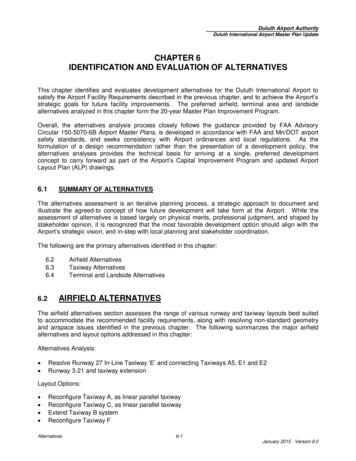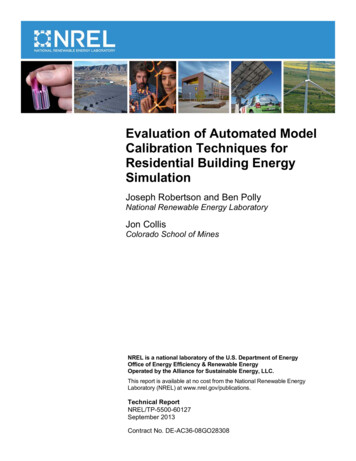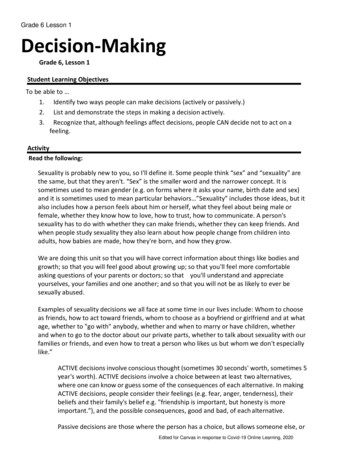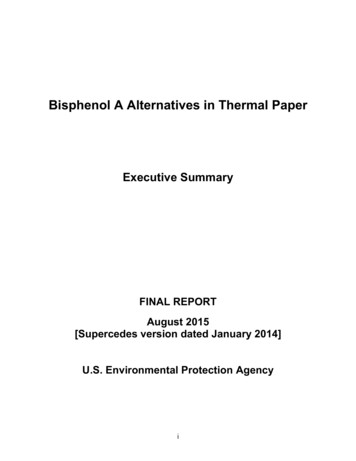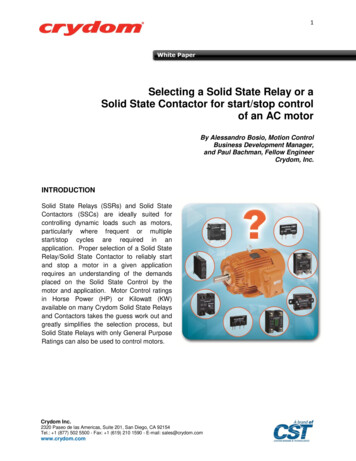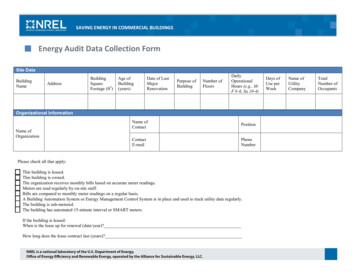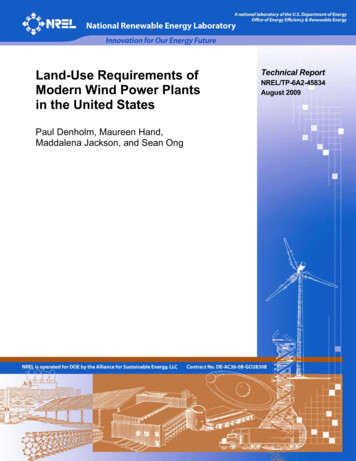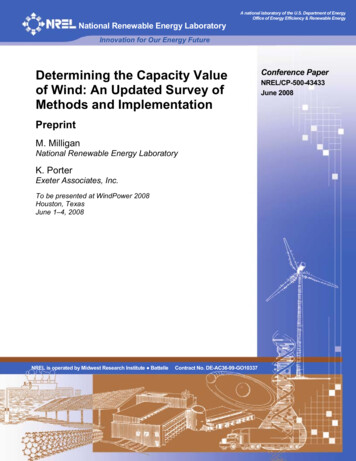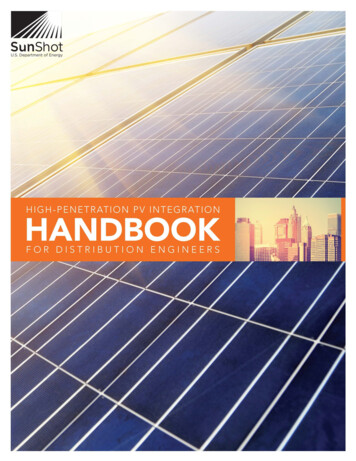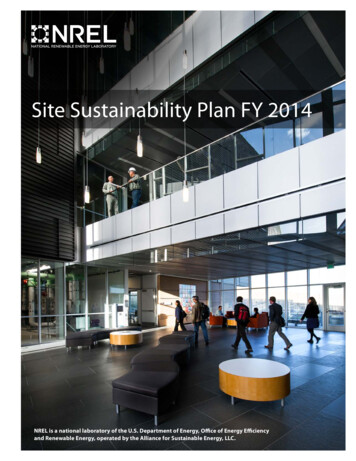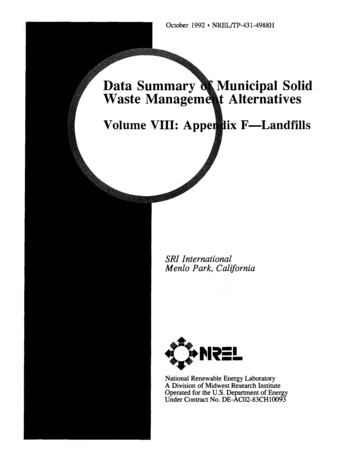
Transcription
October 1992 NREL{fP-431-4988HData SummaryWaste ManagemMunicipal SolidAlternativesVolume VIII: AppF-LandfillsSRI InternationalMenlo Park, California.-. ·lb. .·-···· I!!S- - National Renewable Energy LaboratoryA Division of Midwest Research InstituteOperated for the U.S. Department of EnergyUnder Contract No. DE-AC02-83CH10093
NOTICEfhis report was prepared as an account of work sponsored by an agency of the United States government. Neither the United States government nor any gency thereof, nor any of their employees, makes any warranty, express or implied, or assumes any legal liability or responsibility for the accuracy, com )ieteness, or usefulness of any information, apparatus, product, or process disclosed, or represents that its use would not infringe privately owned rights."'eference herein to any specific commercial product, process, or service by trade name, trademark, manufacture.r,.or otherwise dqes not necessarily con ;titute or imply its endorsement, recommendation, or favoring by the United States government or ariy agency thereof. The views and opinions of authors xpressed herein do not necessarily state or reflect those of the United States government or any agency thereof. .:;.·Printed in the United States of America'Available from:National Technical information Service·U.S. Department of Commerce5285 Port Royal RoadSpringfield, VA 22161Price: Microfiche A01Printed Copy A05 odes are used for pricing all publications. The code is determined by the number of pages .in the publication. lrlformation pertaining to the pricing codes:an be found in the current issue of the following publications which are generally available in most libraries:. Energy Research Abstractso(ERA); Govern nent Reports Announcements and Index ( GRA and I); Scientific and Technical Abstract Reports (STAR); and publication NTIS,PR-360 available from NTIS11 the above address.
NREL!I'P-431-4988H UC Category 249 DE92016433Municipal SolidData SummaryWaste Managem. t AlternativesVolume Vill: Appix F-LandfillsSRI InternationalMenlo Park, CaliforniaNREL Technical Monitors: Bimleshwar GuptaPhilip Shepherdo IU!. National Renewable Energy Laboratory(formerly the Solar Energy Research Institute)1617 Cole BoulevardGolden, Colorado 80401-3393A Division of Midwest Research InstituteOperated for the U.S. Department of Energyunder Contract No. DE-AC02-83CH10093Prepared under subcontract no: RF-1-1103October 1992
Report OrganizationThis report,Data Summary of Municipal Solid Waste Management Alternatives,comprises 12separately bound volumes. Volume I contains th report text Volume II contains supporting exhibits.Volumes III through X are appendices, each addressing a specific MSW management technology.Volumes XI and XII contain project bibliographies. The document. control page at the back of this·volume contains contacts for obtaining copies of the other volumes.VolumeContentsDocument NumberIReport TextTP-431-4988AIIExhibitsTP-431-4988BAppendix ATP-431-4988CIIIMass Bum TechnologiesAppendix BIVTP-431-49880RDF TechnologiesvAppendix CTP-431-4988EFluidized-Bed CombustionVIAppendix DTP-431-4988FPyrolysis and GasificationofMSWVIIAppendix E .TP-431-49880Material Recovery/MaterialRecycling TechnologiesVlllAppendix FTP-431-4988HLandfillsIXAppendix GTP-431-4988IComposting,XAppendix HTP-431-49881Anaerobic Digestion of MSWXIAlphabetically Indexed·XIITP-431-4988KBibliographyNumerically IndexedTP-431-4988LBibliography. ---·- -----
TABLE OF CONTENTSED.Sectjon·;.F.1OVERVIEWF.2F.2.1F.2.1 .1F.2.1 .2F.2.1 7F.2.8F.2.9TECHNOLOGY DESCRIPTIONLandfill LeachateLeachate GenerationLeachate ManagementLechate Treatment and DisposalLiner SystemsDesign Criteria for New MSWLF Units and Lateral ExpansionsLiner Systems Currently in Use ·Groundwater Monitoring WellsLandfill CapsLandfill GasGas ProductionGas ManagementGas UtilizationIndustrial UseElectrical Energy GenerationUpgrading to Pipeline QualityLandfill Gas Recovery System StatusShredfillBalefillTekkaseki Compression SystemReusable LandfillsF.3F.3.1F.3.1 .1F.3.1 .2F.3.1 .3F.3.1 .4F.3.1 .5F.3.1.6F.3.1 .7F.3.2F.3.3F.3.4F.3.5F.3.6ECONOMIC DATALandfill CostsPredevelopment CostsConstruction CostsOperating CostsClosure CostsPost Closure CostsIndirect CostsLandfill Cost ModelsGas Collection System EconomicsGas Recovery System EconomicsTipping FeesBalefill EconomicsReusable Landfill -55F-57F-57F-57F.4F.4.1F.4.2F.4.3ENVIRONMENTAL RELEASES/IMPACTSAcceptability of LandfillsLeachateLandfill GasF-57F-57F-57F-60F.5ENERGY PRODUCTION/REQUIREMENTSF-62F.6ADVANTAGES AND DISADVANTAGES OF LANDFILLING·F-62wTE CORPORATIONF-2F-1 0F.;1 1F-1 1F-1 1F-1 2F-13F-1 5F-1 6. 40F-41
TABLE .OF CONTENTS (Cont)Sectionfasm. F-62: ONCLUSIONSF-64UST OF TABLESfasmIabll.F-1F-2·F-3F-4F-5F-6F-7F-8F-9F-1 0F-1 1F-1 2F-13F-14F-1 5F-1 6F-1 7F-18F-19F-20F-21F-22F-23F-24F-25U.S. Landfill StatisticsKey Features of Fmal RCRA Subtitle D, Part 258 Criteria forMuicipal Solid Waste LandfillsU.S. Landfill Leachate Management Status - 1 988Maximum Concentration LimitsAdvantages aoo Disadvantages of Selected Synthetic LinersVertical Gas Collection Well Advantages and DisadvantagesHorizontal Gas Collection Well Advantages aoo DisadvantagesStatus of Landfill Gas Production Systems - 1987U.S. Landfill Gas Production Systems - 1989 DataLandfill Gas Production RatesTypical Predevelopment Costs - 1988 DataTypical landfill Construction Costs - 1988 DataConstruction Costs - 1984-1986 Data, U.S. MidwestTypical Operations Costs - 1 988 DataTypical Closure Cost - 1 988 DataTypical Post Colsure Costs - 1988 DataApproximate Closure and Post-Closure Costs - 1 988 DataIndirect Costs - 1 988 DataModel Michigan Landfill Cost DataModel Kentucky Landfill Cost Data - 1989 DataSample Landfill Deve lopment Costs - 1988 DataEconomic Data for Selected Gas Recovery FacilitiesLeachate Chemical CharacteristicsComparative Characteristics of Leachate from Singleaoo Recycle CellsLandfill Gas Test Summary - San Francisco Bay AreaF-3-F-7F-1 2F-1 -47F-47F-50F-52F-53F-56F-58F-59F-61LIST OF Leachate Treatment System FlowNew MSWLF Design CriteriaLiner Design AlternativesTypical Monitoring Well Screened Over a Large Vertical IntervalGroundwater Monitoring System Minimum Regulatory RequirementsLandfill Gas ProfileGas Collection WellsGas Extraction WellLandfill Gas PlantF-14F-17F-1 8F-22F-23F-26F-29F-30F-35-wTE CORPORATION------- ------ ------------·----
APPENDIX F. LANDFILLSWhile the preceeding appendices have foaJsed on thermochemical approaches to managing municipalsolid waste (MSW), this appendix and those that follow on COIT1)0sting and anaerobic digestion address· more of the bioconversion process technologies. Landfilling is the historical baseline MSW managementoption central to every community's solid waste management plan.balefills, landfill gas recovery, and landfill mining.Itgenerally encompasses shredfills,While landfilling is virtually universal in use, it continues to undergo intense scrutiny by the public anditsfinal rule oncriteria for designing, operating, monitoring, and closing rrunicipal solid waste landfills.While theregulators alike. Most recently, the U.S. Environmental Protection Agency (EPA) issuedFederal government has established nationwide standards and will assist the States in planning anddeveloping their own practices, the States and local governments will carry out the actual planning anddirect implementation. The States will also be authorized to devise programs to deal with their specificconditions and needs.While the main body of this appendix and corresponding research was originally prepared in July of1 991 , references to the new RCRA Subtitle D, Part 258 EPA regulations have been included in thisresubmission (908). By virtue of timing, this appendix is, necessarily, a "transition" dorument, combiningbasic landfill. design and operation information as well as reference to new regulatory requirements.Given the speed with which landfill practices are and will be changing,the reader is encouraged to refer.I I.to Part 258 for additional details. As States set additional requirements and schedules and owners andoperators of MSW landfills seek to comply, additional guidance and technical information, including casestudies, will likely become available in the literature.In addition to the final Part 258 rule for the control of emissions from RCRA Subtitle D landfills, newsource performance · standards (NSPS) have been proposed for MSW landfills whose construction,modification, or reconstruction begins after a standard is proposed (909). This action addresses airemissions from MSW landfills which contribute to ambient ozone problems, air to)(ic concerns, andpotential explosion hazards. Such an NSPS would require MSW landfill sources to control emissions,particularly nonmethane organic compounds (NMOCs), to the level achievable by "best demonstratedtechnology" (BOT) considering both costs and any nonair quality health and environmental impacts· andenergy requirements. While reference is made to the proposed standards and guidelines throughout thisreport (Appendix F), the proposed rule should be consulted for further details (909).wTe CORPORATIONF-1
F.1OVERVIEWFollowing World War II, concern over air pollution caused landfilling to displace incineration as the·preferred method for the disposal of municipal solid waste (507). However, the early landfills were inreality nothing more than open dulll S. The concept of sanitary landfilling was developed in the early1970s, and, to this day, has remained the most popular method for municipal solid waste ( SW)disposal in the U.S. As shown in Table F-1 , as of 1 990, approximately 80% of the MSW generated in theUnited States was disposed of in landfills (465, 507).Landfilling's popularity can be credited to its low cost and general availability. In the early 1 970s, about1 5,000 authorized MSW landfills existed in the U.S. This number, however, has been steadily declining.As of 1 990, 6,326 active MSW landfills existed in the United States (667). It is projected,· that by 1994,only about 3,332 authorized MSW landfills will exist (659) ; and by 2000, the number of authorized MSWlandfills may drop to less than 1 ,000 (391 ). This dramatic decline can be attributed to three factors: 1 )older landfills are reaching the end of their expected lives; 2) environmental regulations are beingstrengthened; and 3) siting new landfills is increasingly difficult, mainly because of public opposition(372).Certain regions of the country such as the Northeast have experienced more severe landfill shortagesthan other regions and have compensated by developing alternative disposal options such as recycling·and incineration. For other regions with sufficient land area, landfilling remains the predominant disposalmethod (465). Nonetheless, a minimum landfill capacity will always be needed in any particular region toreceive the residue from other disposal options such as recycling and incineration, and to receive thenon-combustible, non-recyclable portion of MSW (372).Regulations regarding the design and operation.of landfills vary from state to state; however, in general,a state-of-the-art landfill contains the following.components (48):Liner systemoo·Leachate collection systemoLeachate treatment systemoCap systemoGas recovery and energy production systemswTe CORPORAnONf·2
TABLE F·1. U.S. LANDFILL STATISTICS, 1990 (661)StateTotalMSW, TPY4, 400, 000·Alabama ( d)511, 000Alaska (b )3 , 1 0 0 , 0 0 0"Ari zona2, 000, 000Arkansas (b )5 0 , 000 , 0 0 0Cali fornia ( f )2, 000, 000·col orado ( d )2 , 90 0 , 0 0 0Connect icut875 , 0 0 0Delaware (C)755 , 0 0 0D i strict of Co lumbia1 8 , 30 0 , 0 0 0Florida4, 400, 000Georgia1 , 200 , 000Hawai i (f)85 0 , 0 0 0Idaho (f)13, 100, 000Il lin ois (f)5, 500, 000Indianna2, 300, 000Iowa (d )1, 60 0, 000Kansas ( a )4 , 600 , 000Kentucky (d)3, 500, 000Louis iana (f )922 , 0 0 0Maine7, 2 0 0 , 0 0 0Maryland ( f )10, 000, 000Mass achusett s (e ) .1 1 , 70 0 , 0 0 0Michigan4, 200, 000Minnesot a ( a )1, 800, 000Mi s s i s s ippi ( f )6, 0 0 0 , 0 0 0Mi ssouri (b )600, 000Montana (e )1, 100, 000Nebraska1, 000, 000Nevada1, 000, 000New Hampshire (d)14, 000, 000New Jersey (b )1, 200 , 000New Mexico22, 00 0 , 0 0 0New York ( f )6, 0 0 0 , 0 0 0North Carol ina (d)450 , 00 0North Dakot a14, 000, 000Ohio ( a )3, 60 0 , 0 0 0Oklahoma2, 200, 000Oregon (d)9, 200, 000Pennsylvania1, 000, 000Rhode Island (d)2, 500, 000South Carol ina (e )500, 000South Dakot a5, 4 0 0 , 000Tennessee (d)wTe CORPORATION%Land Fil ledNo .9385959287804137636485- 9 0839592758 8-919587 - 9 4973873379653961 0714 09273330140603117018 33125478814794481763696-go908 8- 9095685299709497818565 - 7 08 8- 9082869994Cost , / TonRemainingCapacity,Years 45 . 2520up to 1 2 0n/aup t o 22715 - 2 0n/a10 - 2820up to 22n/a60 - 1 0 02 0 35 - 4 5442 55 - 603- 41 0 - 27517 - 5 410up to 1 0812 - 3871210up t o 3 02015414310281 0 15 - 30n/a40757up t o 8 5354565n/an/a35105 41 6 - 25913n/a5 - 158 - 104 - 1320up t o 1 0n/a18 - 60n/a50 - 1502 5n/a9n/an/a10 - 252 0 .158 - 102 0 .158 - 1520 26 - 505 n/a413 - 59105 - 1010 - 153 - 4n/aup to 2 6F·3
TABLE F·1 . U.S. LANDFILL STATISTICS (Cont)%StateTe asUtahVermontVi rgini a (a)West Virgini aWi scons in (a)Wyoming (b )TotalMSW, TPY18, 000,1, 100,350 ,9, 0 0 0 ,1 , 70 0 ,7, 0 0 0 ,300 ,2 92 , 5 1 3 , 0 0 0Tot a l s- - - - - - - - - - - - - - - - - -- - - n/a(a )(b )(c)(d)( e)(f) 000000000000000000000LandF i l ledNo.917867 - 7 0809 0 - 9596979 3450602 9144180100RemainingCost ,Capacity , / TonYears12up to 2 22 0 - 67201 5 - 30n/aup t o 1 015203n/a5n/a2 0 8 0 6 , 32 6-Not AvailableI ncludes some industrial wasteIncludes demo l it ion wasteIncludes s ome sewage s ludge and industrial wasteIncludes s ome demolit ion and industrial wasteI ncludes s ome sewage sludge and demol ition wasteI ncludes demol it ion wastem s ome industrial waste and sewages ludgewTe CORPORATIONF-4
0LandscapingoSecurity systemsooPlan to retum the facility acreage to the communityGroundwater monitoring wellsIn 1 988, the U.S. EPA proposed revisions to the Resource Conservation and Recovery Act (RCRA),Subtitle D r lati()ns. After extensive public conment and review, EPA issued a final rule on 9 October1 991 , with an effective date of 9 October 1 993 (909).The new regulations add a Part 258 to RCRA Subtitle D specifically for rrunicipal solid waste landfills(MSWLFs), including those that co-dispose of sewage sludge with household waste. The new Part 258proposes minimum criteria for MSWLF's primarily in the form of performance standards. Usingperformance standards as opposed to design . standards, EPA is allowing states the flexibility todetermine whether or not specific sites and specific design features will perform to· the minimumperformance standards such that human health and the environment are protected.Part 258 requires that owners and operators of MSWLFs comply with the rule provided the facility wasreceiving MSW on 9 October 1 991 . If the facility has or will terminate operations between this date and9October 1 993, only the final cover requirements of Part 258 apply.H an owner/operator receives wasteon or after .9 October 1993, all of Part 258 applies except the ground water monitoring provisions insubpart E (phased in over a 5-year period), and the financial responsibility provisions of subpart G(effective April 9, 1994).The operational requirements for all owners/operators, on and after the effective date of the rule are to:oExclude the receipt of hazardous wasteoProvide daily coveroControl on-site disease vedorsoProvide routine methane monitoringoEliminate most open bumingoControl public ·accesswTe CORPORAnON·F-5
oConstruct run-on and run-off controlsoControl discharges to surface wateroCease disposal of most liquid wastesoKeep records that demonstrate complianceAn overview of some of the key provisions are presented in Table F-2.Under the authority of the Clean Air Act, the EPA has recently proposed regulations for air pollutantemissions from both new and existing municipal solid waste landfills (909). These regulations willregulate the combustion of methane from landfills as well as the reduction· of nonrnethane organiccompounds (NMOCs) through the use of a gas collection system and an add-on control device. A·designated facility under the proposed guidelines is each existing MSW landfill that has accepted wastesince 8 November 1987, or that has capacity available for futur use.The proposed standards for new MSW landfills (909) are based on best demonstrated technology (BOT)that will reduce emissions from new MSW landfills emitting 1 50 Mgtyr (167 tpy) of NMOC's or more.BOT is defined as a well-designed and well-operatedgascollection system, and a control device.capable of reducing NMOCs in the collected gas by 98 weight-percent. New landfills emitting less than1 50 Mgtyr (1 67 tpy) of NMOCs are not defined under BOT. Therefore, these smaller facilities areexempt from the proposed rule.Proposed guidelines for existing MSW landfills follow the same requirements identified for new MSWlandfills. A well-designed and well-operated collection system is defined as one capable of handling themaximum gas generation rate, capture gas from all parts of the landfill, have a design capable ofmonitoring gas generation and flexible to adjust and expand as needed. The BOT control deviceapplicable to all affected and designated facilities is an open flare that will reduce NMOC emissions by98 weight-percent. Other control devices have been defined by EPA for use in meeting this standard.They can be grouped into two broad categories, including enclosed combustion devices and purificationsystems. Examples of enclosed combustion devices include boilers, gas. turbines, I.C. engines, andincinerators. Purification techniques serve to upgrade landfill gas to pipeline quality natural gas.wTe CORPORATIONF-6
TABLE F·2. KEY FEATURES OF FINAL RCRA SUBTITLE D, PART 258 CRITERIA FOR MUNICIPAL SOLID WASTE LANDFILLS (908, 719, 717)SUBPART A-GENERALObject!ye: Establish minimum national criteria for rn.micipal solid waste landfills (MSWLFs), includingMSWLFs used for sludge disposal and disposal of nonhazardous municipal waste combustor (MWC)ash.Implementation: Approved States will have flexibility in if11)1ementing these criteria.APPlication: Only final cover requirements for facilities that stop receiving waste between October 9,1 991 and October 9, 1993; au requirements for facilities receiving waste on or after October 9, 1993.Exceptions - ground water monitoring and financial requirements extended.SUBPART B-LOCATION RESTRICTIONSLocation of Existing MSWLF Unbs: Specifies minin . m distance to airports (258.1 0) , not to be locatedon 1 00-year floodplain (258.1 1), and effectively barred from wetlands (258.1 2).LocaJion of New UnHs and Lateral Expansion: In addition to stated restriction regarding proximity toairports, floodplains and wetlands, specifies minin . m distance to faults (258.1 3), banned from seismicimpact zone (258.14) and must demonstrate ability to withstand hazards of. unstable land areas (258.15).SUBPART c-oPERATING CRITERIAprocedures· for Excluding theRecelpi of Hazardous Waste 258.20 : lmpiement program to detecthazardous wastes, perform random inspection of loads, maintain inspection records and train personnel.Cover Materlal Requirements 258.21):Provide daily cover of at least six inches of earthen materials.Disease Vector Control 258.22): Prevent or control spread of disease.Explos!ye Gases Control 258.23 : Perform quarterly monitoring to ensure MSWLF methane. concentration does not exceed 25 percent of the lower explosive limit in structures and at MSWLFboundary.·Air Crberla 258.24 : Open burning generally prohibited and compliance required with relevant SIPprovisions.AcceSS Requirements 258.25): Control public access to avoid unlawful dumping or tampering.Bun-on/Bun-off Control Systems (258.26 : Control flow from active portion of MSWLF.governed by surface water requirements (258.27).Run-offSurface water Requirements 258.n): Operate in compliance with National Pollutant DischargeElimination System (NPDES) and Clean Water Act (CWA) requirements.Liquids Restrictions 258.28): Disposal of bulk or containerized liquid waste prohibited EXCEPThousehold wastes (not including septic) AND leachate or gas condensate from MSWLF with compositeliner and leachate collection.wTe CORPORATIONF·7
TABLE F·2. KEY FEATURES OF FINAL RCRA SUBTITLE D, PART 258CRITERIA FOR MUNICIPAL SOLID WASTE LANDFILLS (Cont)SUBPART C - OPERATING CRITERIA (Cont)Becgrdkeeglng Regylremems 258.29): Maintain records such as: inspection records, trainingprocedures, notifications, gas monitoring results, ground-water and corrective action findings or records,closure/post.aosure plan, cost estimates.SUBPART D-DESIGN CRITERIA (258.40)Design Options: Select either site-specifiC design that meets the performance standard stated in therule and approved by Director of an approved State, OR composite liner design.Pedoanance Slandard Design: Not to exceed the maximum concentration limits (MCLs) for Table 1constituents (p. 51 022) in the uppermost aquifer at the relevant point of compliance, which is not to bemore than 1 50 meters from the MSWLF boundary.Comgosne Liner Design : System will consist of two components: upper component to have minimum30-mil flexible membrane liner (FML); and lower component to have minimum two-foot layer ofcompacted soil with a hydraulic conductivity of no more than 1 x 1 o-7 em/sec. [H HOPE material is used,FML must be 60 mil thick).··SUBPART E-GROUND-WATER MONITORING AND CORRECTIVE ACTIONGroynd-Water Monltortng Systems 258.51): Well placement must characterize backgroundground-water not affected by leakage AND water quality passing the relevant point of compliance.Monitoring well casing must be screened and perforated, packed with gravel and sand, and have anannular space above sampling depth that is sealed to prevent contamination.Groynd-Water Sampling and Analysis Requirements (258.53): S&A program will: cover proceduresto collect, analyze and quality assure samples; measure ground water levels; establish backgroundground-water quality; and employ approved statistical methods to determine the number of samples.Detection Monitoring program 258.54): Conduct semiannual detection monitoring during the activelife of the facilityfor the 1 5 organic and 47 inorganic constituents listed in Appendix I to this rule (p.51 033).A sessment ·Monitoring program (258.55): Required whenever a statistically significant increase overbackground occurs for one or more of the Appendix I constituents. Any exceedance triggers requirementDetection of any Appendix II constituentsrequires additional. sampling to stablish background levels. Establish ground-water protectionstandards for all detected constituents from assessment monitoring data.· for sampling for all Appendix II constituents (p. 51 034).Assessment of Corrective Measures 258.56): Whenever any Appendix II constituent exceeds theground water protection standards defined in 258.55, correction action must be initiated.Selection of Remedy 258.5D: Remedies must be: protective of human health and environment; attainground-water protection standards (258.55); control releases of Appendix II constituents to the maximumextent practicable; and comply with all standards for management of wastes (258.58(d)) under RCRA.F-8wTe CORPORATION--------- ----
TABLE F·2. KEY FEATURES OF FINAL RCRA SUBTITLE D, PART 258 CRITERIA FOR MUNICIPAL SOLID WASTE LANDFILLS (Cont)SUBPART E - GROUND-WATER MONITORING AND CORRECTIVE ACTION (Cont)-Implementation of the Correc;tlye Action pmgram 258.581: Establish and implement a correctiveaction program that: meets the requirements of 258.55, states the effectiveness of the selected remedy,and demonstrates compliance with established ground-water protection standards, all on a scheduleacceptable to and certified by the State.SUBPART F-CLOSURE AND POST.CLOSURE CARE'Closure cmerta 258.601: A final cover must be comprised of an erosion layer underlain by aninfiltration layer that is a minimum of 18 inches of earthen material with a permeability equal to or lessthan the permeability of any bottom liner system or natural soils, OR a permeability no greater than 1 x1 o-5 crnlsec, whichever is less. The erosion layer must consist of a minimum of 6 inches of earthenmaterial that is capable of sustaining native plant growth.'Post-Closure Care Requirem ents 1258.611: Required for a period of 30 years, post-closure careconsists of: maintaining the integrity and effectiveness of the final cover; maintaining and operating theleachate collection system; monitoring ground. water; and maintaining and operating the gas monitoringsystem. ·SUBPART G-FINANCIAL ASSURANCE CRITERIAApplicability of Effective pate 1258.70): Effective April 9, 1994.Financial Assurance for Closure 258.71 : Must have an up-to-date e timate for closing the largestarea of all MSWLF units ever requiring a final cover at any time during the active life when the extent andmanner of its operation would make closure most expensive. Must establish financial assurance forclosure (258 74).; )',:Financial Assurance for Post-Closure care 258.721 and Corrective Action 1258.73): Similar.requirements exist for the post-closure care period· and for any corrective actions that may have beenrequired.Allowable Mechanisms 1258.74): As prescribed by this rule, financial assurance for closure,post-closure and corrective action may be accomplished by any one or a combination of: trust fund,surety bond guaranteeing payment or performance, letter of credit, insurance, or State-approvedmechanism.wTe CORPORATIONF·9
The proposed standards and guidelines would also require·the periodic calculation of the annual NMOCemission rate at each affected or designated facility with a maximum design capacity of 1 'oo,ooo Mg.(1 1 0,000 tons) or more. For each facility wherethe.calculated emission rate equals or exceeds theregulatory cutoff of 1 50 Mg/yr (1 67 tpy) of NMOCs, the proposed standards will require the installation of- a well-designed gas collection system and one of several control devices to either recover or destroy theemissions.F.2TECHNOLOGY DESCRIPTIONThree methods of landfilling are presently in Lise: the area, trench, and ramp methods (1 26). The sitecontours determine the method used for a particular site. The area method is used to fill an openrecessed area; the ramp method is used on a sloping site; and the trench method is used on a flat orgently sloping site where the land is excavated systematically in trenches and filled with waste. Eachmethod requires the use of daily cover material. A typical waste to soil (cover) ratio is 4:1 .Daily coverimproves the landfill aesthetics, discourages scavenging by birds, pests, and humans, and helps tocontrol fires and odors.MSW undergoes two changes in a landfill: compaction and degradation. MSW as-delivered has a bulkdensity of 450 to 600 pounds per cubic yard (lb/cy); landfill equipment can increase the density to 800 to1 ,400 lblcy (1 26). Settlement of the landfill is a function f the degree of compaction delivered by thecompaction equipment. A 1 5 percent settlement is typical with good compaction, and a25percentsettlement is. typical with poor compaction (1 26).Degradation of the organic portion of the MSW takes place in five phases. During the first two phases,oxygen is consumed by aerobic bacteria. When the oxygenIsdepleted, faculative and anaerobicmicroorganisms. take over. Phase three is the first of the three anaerobic stages and is characterized bya low pH (4-5), a high volatile acid production, a high Chemical Oxygen Demand (COD), highconductivity, and low methane production. In phase four, the second of the three anaerobic stages,methane producing bacteria predominate. They degrade volatile acids to methane and carbon dioxide,causing a rise in pH, a decrease in COD, and a reduction in conductivity. The methane to carbondioxide ratio is approximately 50/50, depending on the activity of the methane-producing bacteria inrelation to other microbial forms, and also on the nature of the organic matter in the· MSW (1 26).Methane gas produced in a landfill can be collected, processed, and converted to energy. The final fifthphase results in the stabilization of the landfill.wTe CORPORATIONF·10
Since a landfiU is constantly evolving, the five phases are ·not distinct and may occur siiTI.IItaneouslythroughout the landfill. All phases will Occur if sufficient organic material and moisture is avai le, and if.the bacteria are not inhibited by any chemical·source (323). The five phases are typically referred to asa combined singular process.F.2.1Landfill LeachateF.2.1 .1 Leachate GenerationLeachate is generated by precipitation or groundwater percolating through the landfill mass and by thedraining of fluids contained in the MSW.The quantityof leachate is much higher while the landfill isopen, but it is ultimately controlled to some extent after the installation of the low penneability landfill cap.Leachate cannot be completely eliminated because water cannot be totally prevented from entering thelandfill mass.Cracks can develop from freeze-thaw and wet-dry cycles, or from subsidence anddifferential settling (585). As water flows , wnward through the landfill mass, it reacts both chemicallyand physically with the waste. Contaminants from the waste and the reactions occurring in the
Report Organization This report, Data Summary of Municipal Solid Waste Management Alternatives, comprises 12 separately bound volumes. Volume I contains th report text Volume II contains supporting exhibits. Volumes III through X are appendices, each addressing a specific MSW management technology. Volumes XI and XII contain project bibliographies.
